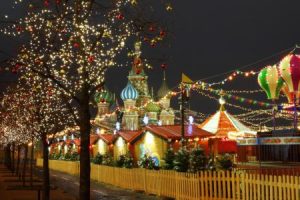
The Nativity of Christ is the second most important holiday in the Orthodox calendar, in Russia. It is celebrated every January 7, not only at the church, but also the whole country. It is also one of the most ancient holidays that have survived to this day. Over the past centuries, the celebration of Christmas has overgrown with many traditions, rites and rituals.
Something unique about the celebration of Christmas in Russia is that it used to follow the Julian calendar, or the “Old Style” calendar which is set every December 25th, just like the rest of the world. The Orthodox tradition marked the day as the first day of the festivity week that would end on January 1st. But, today, Russia uses the Gregorian calendar that shifted the Christmas celebration to January 7th. This is just one point that makes the day different and special in Russia.
The History of Christmas in Russia
In Russia, the holiday first appeared with the advent of Christianity – around the tenth century. And, starting from the XVII-XVIII centuries, European traditions of celebrating Christmas began to take root in Russia. First of all, this is the custom brought from Germany to put a dressed-up tree with a Christmas star at the top for celebration, as well as the fashion for nativity theaters and – in the 19th century – the appearance of the native Russian Santa Claus – Ded Moroz, who, just like in Europe, was associated primarily with St. Nicholas.
After the revolution, Christmas in the Soviet Union actually fell under the ban. But in the 1930s, the government decided to return the winter holiday to the people, and the traditions of Christmas partly migrated to the New Year, but in a completely secular format. Christmas was officially restored to its rights only in post-Soviet times, and this holiday again acquired approximately the same features that it had before the revolution. At the same time, the secular New Year remained the main winter holiday in Russia, so those who obediently observe the Christmas fast have to put up with this tradition.
Today, Christmas is an official day off, and the festive events taking place on this day are included in the ten-day New Year holidays provided to the Russians.
Christmas Tree
Today it stands in a house in a prominent place, and everyone is trying to decorate it as elegantly as possible. This tradition started 200 years ago, in December 1817, and brought to the Russian Empire by the Grand Duchess Alexandra Fedorovna, the future empress, the wife of Nicholas I.
The tradition of the imperial Christmas tree still continues. Today, the Kremlin tree is a real ball. It has been held for 80 years. For several generations, it was the main tree of the country, and not only for children, but for parents too. Visiting the Kremlin Christmas tree was like going to Disneyland today.
How Christians in Russia Prepare for Christmas
Believers observe the Christmas fast, and on January 6 – the last day of the Christmas Lent – the strictest fasting day. It’s called Christmas Eve. On this day they do not eat food until the evening, until the stars are visible in the sky.
The last night before Christmas is called the Holy. By this moment, the housewives should have time to prepare a festive table. For dinner, it is customary to put twelve lean dishes on the table (fast food is allowed to be eaten only the next day). The number 12 is also symbolic. These are the 12 apostles of Christ, and 12 months of the year, and 12 major holidays of the Church. The main course of the table on the evening is kutya. This is a dish of boiled grains, usually wheat, with honey, nuts, poppy seeds and raisins. A small piece of hay is placed under a plate with kutya as a reminder of the birthplace of Christ. Each of the 12 dishes should be tried at least a little bit – none of them should remain untouched. The dishes are usually served cold, and the soup is only a little warm, because the hostess should not get up from the table and go to the kitchen to heat it up.
The Russian Folk Tradition to Celebrate Christmas
On this day in people would make sure they have a pine tree, decorated with toys and candles – in memory of the star that lit up the night at the time of the birth of Jesus. Gifts are placed under the tree for loved ones. Christmas is a family holiday, so in the evening, all family members gather at home, and the children help the elders. January 7 is a real feast. The goose with apples became the main dish together with boiled pork and brisket.
At Christmas, it is customary to wear only new and clean clothes. An ancient tradition that has survived to this day is caroling. Russians, having changed clothes, go from house to house, sing carols and praise the baby Christ. For this, the owners of the house should give them money or treats.
In Russia, the holiday of the Nativity of Christ is now included in a series of New Year’s holidays. For some families, the main thing is to celebrate the New Year, others do not celebrate the New Year, but prepare for Christmas. Gifts are also given as is customary in a particular family, and can be given for both holidays. Despite the difference of belief, Christmas is always celebrated peacefully in Russia, and this is why it is a special holiday in the country.
